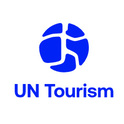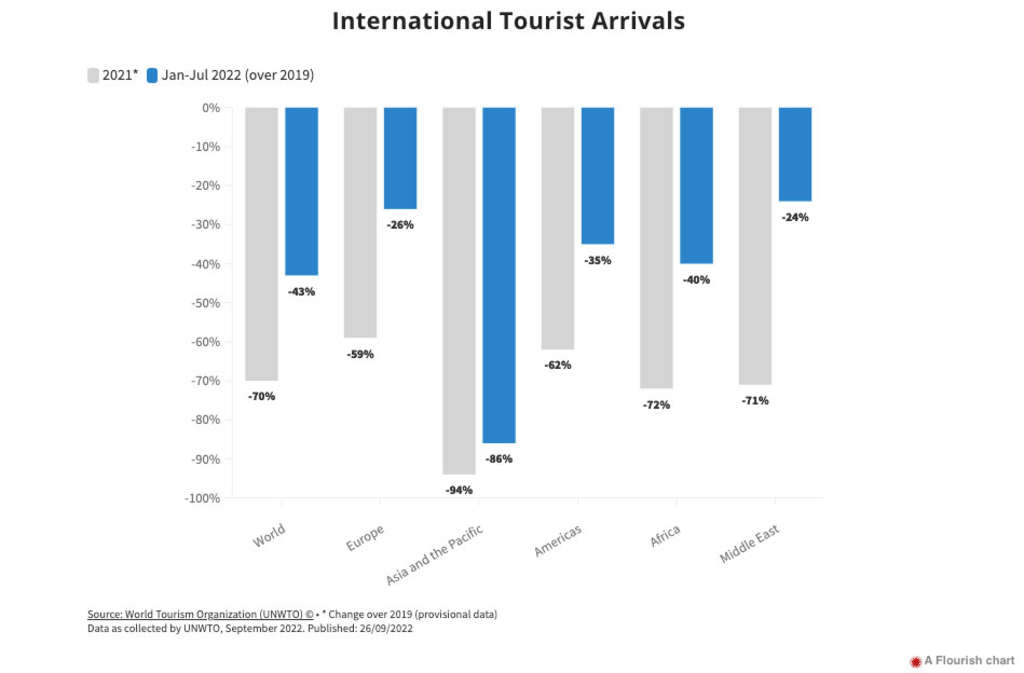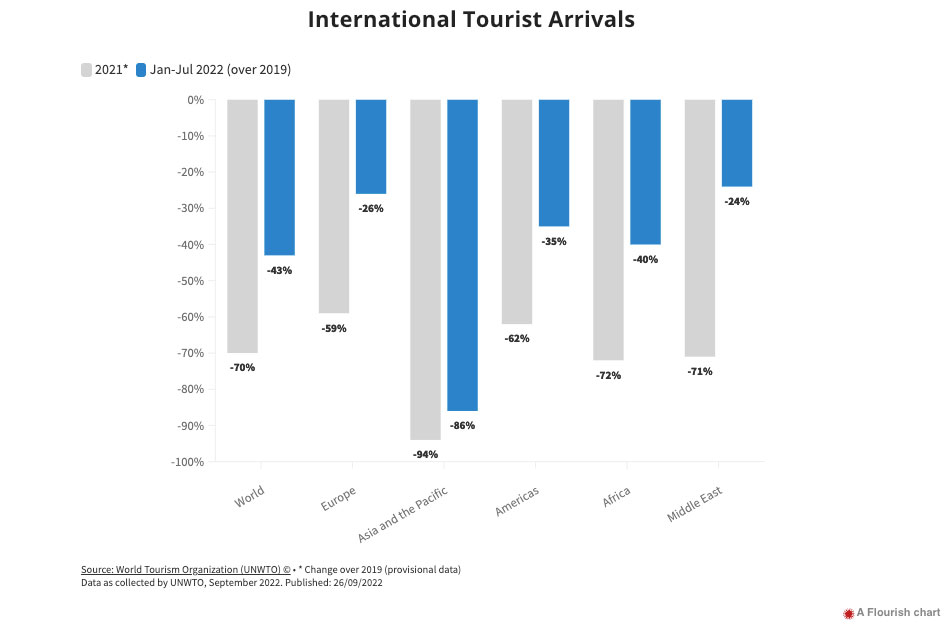International Tourism Back to 60% of Pre-Pandemic Levels in January-July 2022
International tourism continued to show strong signs of recovery, with arrivals reaching 57% of pre-pandemic levels in the first seven months of 2022.
According to the latest UNWTO World Tourism Barometer, international tourist arrivals almost tripled in January to July 2022 (+172%) compared to the same period of 2021. This means the sector recovered almost 60% of pre-pandemic levels. The steady recovery reflects strong pent-up demand for international travel as well as the easing or lifting of travel restrictions to date (86 countries had no COVID-19 related restrictions as of 19 September 2022).
UNWTO Secretary-General Zurab Pololikashvili said: “Tourism continues to recover steadily, yet several challenges remain, from geopolitical to economic. The sector is bringing back hope and opportunity for people everywhere. Now is also the time to rethink tourism, where it is going and how it impacts people and planet.”
An estimated 474 million tourists travelled internationally over the period, compared to the 175 million in the same months of 2021. An estimated 207 million international arrivals were recorded in June and July 2022 combined, over twice the numbers seen in the same two months last year. These months represent 44% of the total arrivals recorded in the first seven months of 2022. Europe welcomed 309 million of these arrivals, accounting for 65% of the total.
International Tourist Arrivals
Europe and the Middle East Lead Recovery
Europe and the Middle East showed the fastest recovery in January-July 2022, with arrivals reaching 74% and 76% of 2019 levels respectively. Europe welcomed almost three times as many international arrivals as in the first seven months of 2021 (+190%), with results boosted by strong intra-regional demand and travel from the United States. The region saw particularly robust performance in June (-21% over 2019) and July (-16%), reflecting a busy summer period. Arrivals climbed to about 85% of 2019 levels in July. The lifting of travel restrictions in a large number of destinations also fuelled these results (44 countries in Europe had no COVID-19 related restrictions as of 19 September 2022).
The Middle East saw international arrivals grow almost four times year-on-year in January-July 2022 (+287%). Arrivals exceeded pre-pandemic levels in July (+3%), boosted by the extraordinary results posted by Saudi Arabia (+121%) following the Hajj pilgrimage.
The Americas (+103%) and Africa (+171%) also recorded strong growth in January-July 2022 compared to 2021, reaching 65% and 60% of 2019 levels respectively. Asia and the Pacific (+165%) saw arrivals more than double in the first seven months of 2022, though they remained 86% below 2019 levels, as some borders remained closed to non-essential travel.
Subregions and destinations
Several subregions reached 70% to 85% of their pre-pandemic arrivals in January-July 2022. Southern Mediterranean Europe (-15% over 2019), the Caribbean (-18%) and Central America (-20%) showed the fastest recovery towards 2019 levels. Western Europe (-26%) and Northern Europe (-27%) also posted strong results. In July arrivals came close to pre-pandemic levels in the Caribbean (-5%), Southern and Mediterranean Europe (-6%) and Central America (-8%).
Among destinations reporting data on international arrivals in the first five to seven months of 2022, those exceeding pre-pandemic levels were: the US Virgin Islands (+32% over 2019), Albania (+19%), Saint Maarten (+15%), Ethiopia and Honduras (both +13%), Andorra (+10%), Puerto Rico (+7%), United Arab Emirates and Dominican Republic (both +3%), San Marino and El Salvador (both +1%) and Curaçao (0%).
Among destinations reporting data on international tourism receipts in the first five to seven months of 2022, Serbia (+73%), Sudan (+64%), Romania (+43%), Albania (+32%), North Macedonia (+24%), Pakistan (+18%), Türkiye, Bangladesh and Latvia (all +12%), Mexico and Portugal (both +8%), Kenya (+5%) and Colombia (+2%) all exceeded pre-pandemic levels in January-July 2022.
Tourism spending rises but challenges grow
The ongoing recovery can also be seen in outbound tourism spending from major source markets. Expenditure from France climbed to -12% in January-July 2022 compared to 2019 while spending from Germany rose to -14%. International tourism spending stood at -23% in Italy and -26% in the United States.
Robust performance was also recorded in international passenger air traffic, with a 234% increase in January-July 2022 (45% below 2019 levels) and a recovery of some 70% of pre-pandemic traffic levels in July, according to IATA.
Stronger-than-expected demand has also created important operational and workforce challenges in tourism companies and infrastructure, particularly airports. Additionally, the economic situation, exacerbated by the aggression of the Russian Federation against Ukraine, represents a major downside risk. The combination of increasing interest rates in all major economies, rising energy and food prices and the growing prospects of a global recession as indicated by the World Bank, are major threats to the recovery of international tourism through the remainder of 2022 and 2023. The potential slowdown can be seen in the latest UNWTO Confidence Index, which reflects a more cautious outlook, as well as in booking trends which are showings signs of slower growth.
Tourism Experts Cautiously Confident
On a scale of 0 to 200, the UNWTO Panel of Tourism Experts rated the period May-August 2022 with a score of 125, matching the bullish expectations expressed by the Panel in the May survey for the same 4-month period (124).
Prospects for the remainder of the year are cautiously optimistic. Although above-average performance is expected, tourism experts rated the period September-December 2022 with a score of 111, below the 125 score of the previous four months, showing a downgrade in confidence levels. Almost half of experts (47%) see positive prospects for the period September-December 2022, while 24% expect no particular change and 28% consider it could be worse. Experts also seem confident about 2023, as 65% see better tourism performance than in 2022.
The uncertain economic environment seems to have nonetheless reversed prospects for a return to pre-pandemic levels in the near term. Some 61% of experts now see a potential return of international arrivals to 2019 levels in 2024 or later while those indicating a return to pre-pandemic levels in 2023 has diminished (27%) compared to the May survey (48%). According to experts, the economic environment continues to be the main factor weighing on the recovery of international tourism. Rising inflation and the spike in oil prices results in higher transport and accommodation costs, while putting consumer purchasing power and savings under pressure.
RELATED LINKS
- UNWTO World Tourism Barometer | Volume 20 • Issue 5 • September 2022 | EXCERPT
- Impact of the Russian offensive in Ukraine on international tourism
- UNWTO Tourism Data Dashboard
- World Tourism Day 2022: Rethinking Tourism
About UN Tourism
The World Tourism Organization (UN Tourism) is the United Nations agency responsible for the promotion of responsible, sustainable and universally accessible tourism.
As the leading international organization in the field of tourism, UN Tourism promotes tourism as a driver of economic growth, inclusive development and environmental sustainability and offers leadership and support to the sector in advancing knowledge and tourism policies worldwide.
Our Priorities
Mainstreaming tourism in the global agenda: Advocating the value of tourism as a driver of socio-economic growth and development, its inclusion as a priority in national and international policies and the need to create a level playing field for the sector to develop and prosper.
Promoting sustainable tourism development: Supporting sustainable tourism policies and practices: policies which make optimal use of environmental resources, respect the socio-cultural authenticity of host communities and provide socio-economic benefits for all.
Fostering knowledge, education and capacity building: Supporting countries to assess and address their needs in education and training, as well as providing networks for knowledge creation and exchange.
Improving tourism competitiveness: Improving UN Tourism Members' competitiveness through knowledge creation and exchange, human resources development and the promotion of excellence in areas such as policy planning, statistics and market trends, sustainable tourism development, marketing and promotion, product development and risk and crisis management.
Advancing tourism's contribution to poverty reduction and development: Maximizing the contribution of tourism to poverty reduction and achieving the SDGs by making tourism work as a tool for development and promoting the inclusion of tourism in the development agenda.
Building partnerships: Engaging with the private sector, regional and local tourism organizations, academia and research institutions, civil society and the UN system to build a more sustainable, responsible and competitive tourism sector.
Our Structure
Members: An intergovernmental organization, UN Tourism has 160 Member States, 6 Associate Members, 2 Observers and over 500 Affiliate Members.
Organs: The General Assembly is the supreme organ of the Organization. The Executive Council take all measures, in consultation with the Secretary-General, for the implementation of the decisions and recommendations of the General Assembly and reports to the Assembly.
Secretariat: UN Tourism headquarters are based in Madrid, Spain. The Secretariat is led by the Secretary-General and organized into departments covering issues such as sustainability, education, tourism trends and marketing, sustainable development, statistics and the Tourism Satellite Account (TSA), destination management, ethics and risk and crisis management. The Technical Cooperation and Silk Road Department carries out development projects in over 100 countries worldwide, while the Regional Departments for Africa, the Americas, Asia and the Pacific, Europe and the Middle East serve as the link between UN Tourism and its 160 Member States. The Affiliate Members Department represents UN Tourism's 500 plus Affiliate members.
UNWTO Communications Department
+34 91 567 8100
UN Tourism


